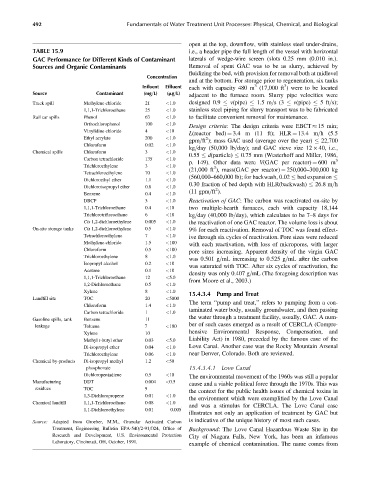Page 537 - Fundamentals of Water Treatment Unit Processes : Physical, Chemical, and Biological
P. 537
492 Fundamentals of Water Treatment Unit Processes: Physical, Chemical, and Biological
open at the top, downflow, with stainless steel under-drains,
TABLE 15.9 i.e., a header pipe the full length of the vessel with horizontal
GAC Performance for Different Kinds of Contaminant laterals of wedge-wire screen (slots 0.25 mm (0.010 in.).
Sources and Organic Contaminants Removal of spent GAC was to be as slurry, achieved by
fluidizing the bed, with provision for removal both at midlevel
Concentration
and at the bottom. For storage prior to regeneration, six tanks
3
3
Influent Effluent each with capacity 480 m (17,000 ft ) were to be located
Source Contaminant (mg=L) (mg=L) adjacent to the furnace room. Slurry pipe velocities were
Truck spill Methylene chloride 21 <1.0 designed 0.9 v(pipe) 1.5 m=s(3 v(pipe) 5ft=s);
1,1,1-Trichloroethane 25 <1.0 stainless steel piping for slurry transport was to be fabricated
Rail car spills Phenol 63 <1.0 to facilitate convenient removal for maintenance.
Orthochlorophenol 100 <1.0
Design criteria: The design criteria were EBCT 15 min;
Vinylidine chloride 4 <10
L(reactor bed) ¼ 3.4 m (11 ft); HLR ¼ 13.4 m=h (5.5
Ethyl acrylate 200 <1.0 2
gpm=ft ); mass GAC used (average over the year) 22,700
Chloroform 0.02 <1.0
kg=day (50,000 lb=day); and GAC sieve size 12 40, i.e.,
Chemical spills Chloroform 3 <1.0
0.55 d(particle) 0.75 mm (Westerhoff and Miller, 1986,
Carbon tetrachloride 135 <1.0 3
p. 149). Other data were V(GAC per reactor) ¼ 600 m
Trichloroethylene 3 <1.0 3
(21,000 ft ), mass(GAC per reactor) ¼ 250,000–300,000 kg
Tetrachloroethylene 70 <1.0
Dichloroethyl ether 1.1 <1.0 (560,000–660,000 lb); for backwash, 0.02 bed expansion
0.30 fraction of bed depth with HLR(backwash) 26.8 m=h
Dichloroisopropyl ether 0.8 <1.0
2
(11 gpm=ft ).
Benzene 0.4 <1.0
DBCP 3 <1.0 Reactivation of GAC: The carbon was reactivated on-site by
1,1,1-Trichloroethane 0.4 <10 two multiple-hearth furnaces, each with capacity 18,144
Trichlorotrifloroethane 6 <10 kg=day (40,000 lb=day), which calculates to be 7–8 days for
Cis 1,2-dichloroethylene 0.005 <1.0 the reactivation of one GAC reactor. The volume loss is about
On-site storage tanks Cis 1,2-dichloroethylene 0.5 <1.0 9% for each reactivation. Removal of TOC was found effect-
Tetrachloroethylene 7 <1.0 ive through six cycles of reactivation. Pore sizes were reduced
Methylene chloride 1.5 <100
with each reactivation, with loss of micropores, with larger
Chloroform 0.5 <100 pore sizes increasing. Apparent density of the virgin GAC
Trichloroethylene 8 <1.0
was 0.501 g=mL increasing to 0.525 g=mL after the carbon
Isopropyl alcohol 0.2 <10
was saturated with TOC. After six cycles of reactivation, the
Acetone 0.1 <10
density was only 0.407 g=mL (The foregoing description was
1,1,1-Trichloroethane 12 <5.0
from Moore et al., 2003.)
1,2-Dichloroethane 0.5 <1.0
Xylene 8 <1.0
15.4.3.4 Pump and Treat
Landfill site TOC 20 <5000
The term ‘‘pump and treat,’’ refers to pumping from a con-
Chloroform 1.4 <1.0
taminated water body, usually groundwater, and then passing
Carbon tetrachloride 1 <1.0
the water through a treatment facility, usually, GAC. A num-
Gasoline spills, tank Benzene 11
ber of such cases emerged as a result of CERCLA (Compre-
leakage Toluene 7 <100
hensive Environmental Response, Compensation, and
Xylene 10
Methyl t-butyl ether 0.03 <5.0 Liability Act) in 1980, preceded by the famous case of the
Di-isopropyl ether 0.04 <1.0 Love Canal. Another case was the Rocky Mountain Arsenal
Trichloroethylene 0.06 <1.0 near Denver, Colorado. Both are reviewed.
Chemical by-products Di-isopropyl methyl 1.2 <50
phosphonate 15.4.3.4.1 Love Canal
Dichloropentadiene 0.5 <10
The environmental movement of the 1960s was still a popular
Manufacturing DDT 0.004 <0.5
cause and a viable political force through the 1970s. This was
residues TOC 9
the context for the public health issues of chemical toxins in
1,3-Dichloropropene 0.01 <1.0
the environment which were exemplified by the Love Canal
Chemical landfill 1,1,1-Trichloroethane 0.08 <1.0
and was a stimulus for CERCLA. The Love Canal case
1,1-Dichloroethylene 0.01 0.005
illustrates not only an application of treatment by GAC but
Source: Adapted from Groeber, M.M., Granular Activated Carbon is indicative of the unique history of most such cases.
Treatment, Engineering Bulletin EPA-540=2-91=024, Office of Background: The Love Canal Hazardous Waste Site in the
Research and Development, U.S. Environmental Protection City of Niagara Falls, New York, has been an infamous
Laboratory, Cincinnati, OH, October, 1991.
example of chemical contamination. The name comes from

